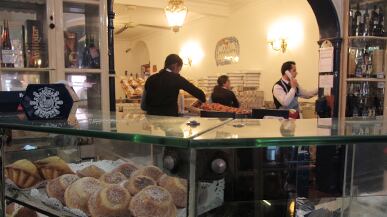The French may be more famous for their pastry, but for Molly Hannon it’s hard to beat a visit to Lisbon’s historical shop of delicacies, Pasteis de Belem.
In the city of Lisbon where orange trees and the smell of sea salt perfume the air, one can expect to find more than sardines and Vino Verde. Since 1837, Pasteis de Belem has satiated the city's sweet tooth, becoming a landmark of Portuguese gastronomic pride.
It all began in the Belem district's Hieronymites Monastery when the monks, their livelihoods threatened by the liberal revolution of the 1820s, decided to use their ties to a sugar cane refinery and a local general store to fight for survival.

The monastery began crafting its own delicacies, later known as pasteis de belem. The pastries were then sold at the general store nearby. Pasteis de Belem has remained an institution in Lisbon, managing to get through both World War I and II sugar rationing as loyal patrons made sure it received its regular supply.
Today, Belem still honors its sweet and virtuous history. The puff pastry is made by hand by three main pastry chefs who upon initiation must take a secret oath (i.e. sign a contract) in order to safeguard its almost 200-year-old recipe.
With 150 employees, Belem carries a certain old-world charm. The whitewashed facade tinged with deep Moorish blues gives it its unique and inviting allure. The entrance holds shelves of preserves such as marmalades and a glass case features buttery delights from eclairs to croissants. But as one moves back, one quickly discovers that Belem is somewhat of a maze. Here, tourists and locals sit side by side indulging in the house specialty— pasteis paired with strong Portuguese café. It differs greatly from the cafes of Paris, Rome, and other notable café cultures, which adds to Belem’s unique charm.
My own encounter with Belem began on an auspicious day. With gray clouds and rain, my first Monday morning in Portugal did not look promising. After a decadent weekend in the company of friends, I found myself in a dodgy hotel flanked by eager minds and stomachs. My school study trip had begun and my classmates, new to the city, were sure to have their fill. Our tour guide, Victor, clad in army green and with a bellowing voice, rallied us, his new batch of troops. With our drill sergeant leading the way, we set out for Pasteis de Belem.
It was a beautiful fusion of Spanish and French custard, yet still possessed its own distinct and inviting taste.
Pastry is a beloved and loyal friend of mine. I have never considered it the enemy even during the lumpier parts of the year. The French principle of less is more applies and the best part is surely in the first bite. At Pasteis de Belem, this rule applies.
As we moved into the shop, I immediately smelled the buttery aroma in the air. The espresso machine's whistle reminded me of my breakfast earlier that morning of sub-par toast with high fructose jam, which I quickly regretted. Victor, true to form, shuffled us to the back where our tour began with the manager, who relayed the history of Pasteis de Belem.
Listening to our tour guide, I could not help but notice movement behind the glass panes. There were the pastry chefs clad in white, diligently working and immune to our frenzied picture-taking. Ovens flanked the wall, and soon delicacies began to emerge. I could barely contain myself with the anticipation of what was to come.
As our tour concluded, we moved to the back of the house. Some sat patiently while others chatted away. More cameras flashed and then suddenly, a silver tray wheeled out carrying our morning fare.
The room fell silent with the arrival of the pasteis which upon further inspection looked more like a mini quiche than a pastry. Its flaky and slightly burned crust was reminiscent of crème brulee. But it was neither hard nor caramelized. And its interior was like a custard—specifically flan. It was a beautiful fusion of Spanish and French custard, yet still possessed its own distinct and inviting taste.
As my class and I chewed softly savoring every bite, I thought back on our early morning tour witnessing the pastry emerge from the oven. With both its history and taste fresh in my mind and mouth, I thought this is surely pastry at best.
Molly Hannon is a food and travel writer based in Europe.






